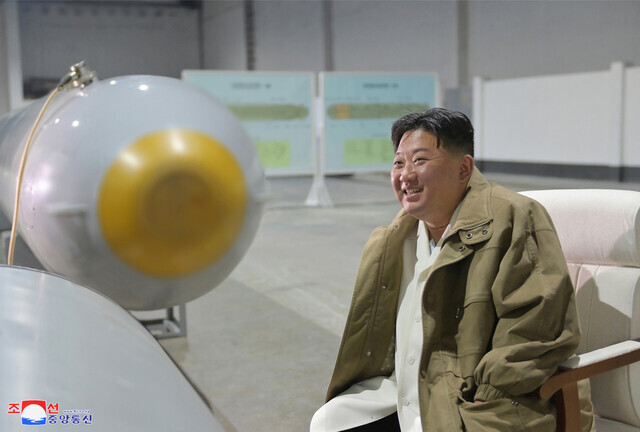hankyoreh
Links to other country sites 다른 나라 사이트 링크
[Editorial] N. Korea’s shows of nuclear might only fuel the regional arms race

The joint exercises by the South Korean and US militaries, which wrapped up on Thursday, was met by North Korea with various demonstrations of its nuclear capabilities. North Korea unveiled a series of new nuclear-capable weapons, from submarine-launched cruise missiles (SLCM) to nuclear torpedoes.
As North Korea ratchets up its nuclear threat by developing a variety of launch vehicles to neutralize South Korea and the US’ extended deterrence, tensions on the Korean Peninsula and the arms race are growing exceedingly precarious.
In response to the Freedom Shield drill held from March 13 to March 23, North Korea unveiled several new strategic weapons. Starting with an SLCM on March 12, it claimed to have launched and detonated a short-range ballistic missile (SRBM) and a cruise missile in the air, 600-800 meters above its target, on March 19 and March 22.
The aerial detonation of nuclear warheads is intended to maximize the kill radius; the atomic bomb dropped on Hiroshima during World War II had a blast altitude of 570 meters.
On March 21-23, North Korea claimed that it conducted underwater explosion tests on an “unmanned underwater nuclear attack craft,” which appears to be an underwater drone-type nuclear torpedo.
While South Korea’s Ministry of National Defense believes that North Korea has not yet deployed missiles tipped with miniaturized nuclear warheads, there is concern that the North is rapidly developing the capability to launch nuclear weapons in various ways that could allow it to avoid detection, strike, and interception by South Korea and the US.
In the past, North Korea has avoided direct military action during joint South Korea-US military drills, but since adopting its nuclear use doctrine in September 2022, it has become emboldened in its responses. South Korea, the United States, and Japan have, in turn, escalated their military responses, creating a vicious cycle.
While the Freedom Shield joint drills have ended for now, the South Korea-US navies and marine corps will continue their biennial combined “Ssangyong” (“double dragon”) amphibious exercise through April 3. South Korea and the US are also scheduled to hold a “joint firepower annihilation drill” in June, which will feature a swath of advanced military forces, to mark the 70th anniversary of the South Korea-US alliance and the Korean Armistice Agreement. North Korea will respond by further escalating its nuclear threats.
The situation on the Korean Peninsula is intertwined with the arms race in East Asia as a whole. The New York Times published an analysis on Saturday illustrating that the intensifying strategic rivalry between the US and China is making Asian countries worried, which is making them rush to build up their military capabilities. As such, the most significant arms race in Asia since World War II has commenced, which is fueling instability in the region.
In 2000, countries in the Asia Pacific accounted for just 17.5% of global defense spending, but by 2021, that figure had soared to 27.7%, excluding North Korea. Failure to break the cycle of fear will leave all parties to face dire consequences.
Please direct questions or comments to [english@hani.co.kr]

Editorial・opinion
![[Guest essay] The real reason Korea’s new right wants to dub Rhee a founding father [Guest essay] The real reason Korea’s new right wants to dub Rhee a founding father](https://flexible.img.hani.co.kr/flexible/normal/500/300/imgdb/original/2024/0423/8317138574257878.jpg) [Guest essay] The real reason Korea’s new right wants to dub Rhee a founding father
[Guest essay] The real reason Korea’s new right wants to dub Rhee a founding father![[Column] ‘Choson’: Is it time we start referring to N. Korea in its own terms? [Column] ‘Choson’: Is it time we start referring to N. Korea in its own terms?](https://flexible.img.hani.co.kr/flexible/normal/500/300/imgdb/original/2024/0423/3617138579390322.jpg) [Column] ‘Choson’: Is it time we start referring to N. Korea in its own terms?
[Column] ‘Choson’: Is it time we start referring to N. Korea in its own terms?- [Editorial] Japan’s rewriting of history with Korea has gone too far
- [Column] The president’s questionable capacity for dialogue
- [Column] Are chaebol firms just pizza pies for families to divvy up as they please?
- [Column] Has Korea, too, crossed the Rubicon on China?
- [Correspondent’s column] In Japan’s alliance with US, echoes of its past alliances with UK
- [Editorial] Does Yoon think the Korean public is wrong?
- [Editorial] As it bolsters its alliance with US, Japan must be accountable for past
- [Guest essay] Amending the Constitution is Yoon’s key to leaving office in public’s good graces
Most viewed articles
- 1[Column] ‘Choson’: Is it time we start referring to N. Korea in its own terms?
- 2Opposition calls Yoon’s chief of staff appointment a ‘slap in the face’
- 3[Guest essay] The real reason Korea’s new right wants to dub Rhee a founding father
- 4Senior doctors cut hours, prepare to resign as government refuses to scrap medical reform plan
- 5Why Korea shouldn’t welcome Japan’s newly beefed up defense cooperation with US
- 6New AI-based translation tools make their way into everyday life in Korea
- 7[Editorial] Japan’s rewriting of history with Korea has gone too far
- 8Terry Anderson, AP reporter who informed world of massacre in Gwangju, dies at 76
- 9[Column] Has Korea, too, crossed the Rubicon on China?
- 10[Column] The clock is ticking for Korea’s first lady